|
SOUND AND POLLUTION BARRIERS
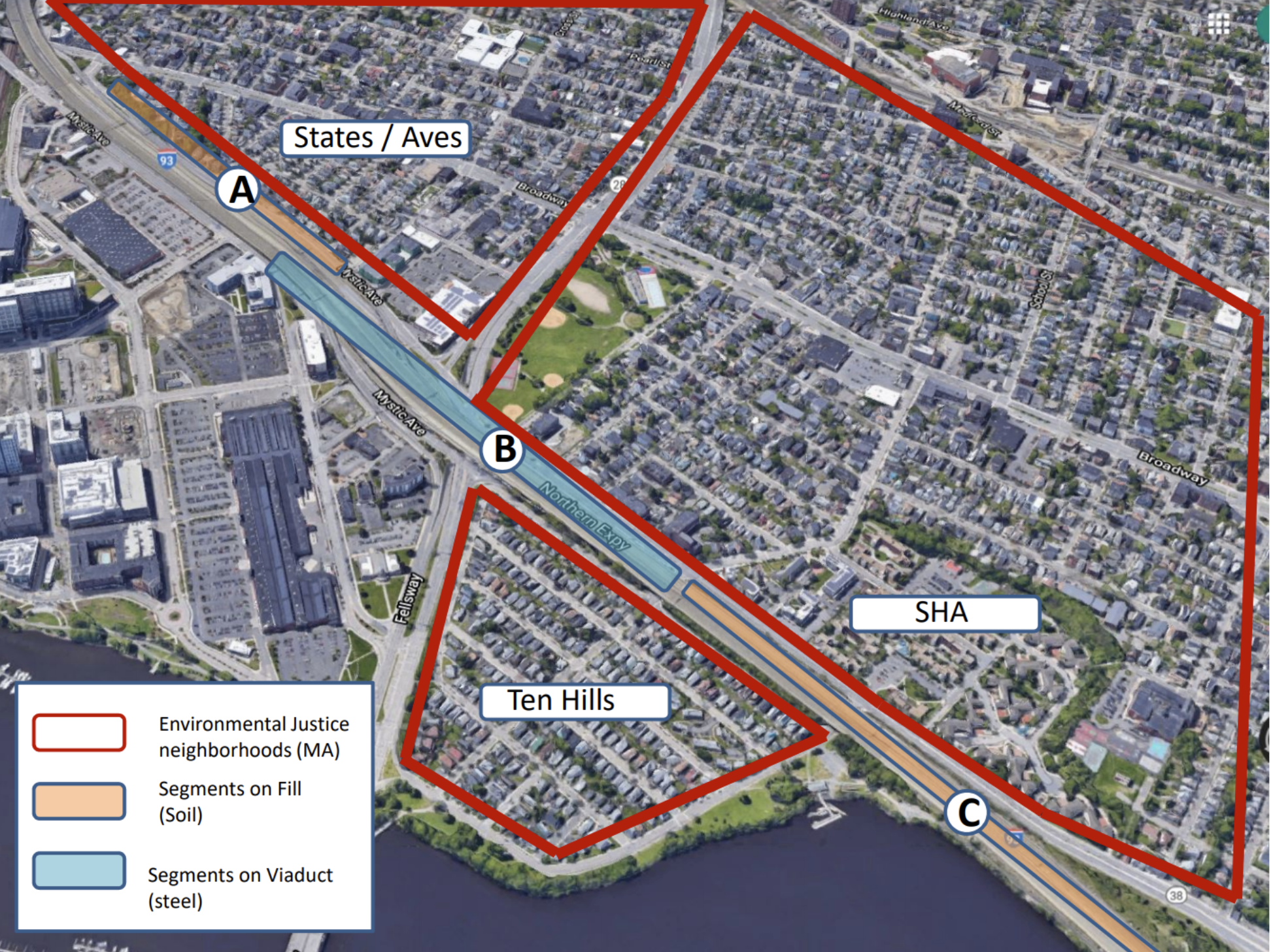 For
60 years, traffic on I-93 has poured air pollution and noise onto
residents along its path in the lowest income part of Somerville. For
decades, activists have pushed for sound barriers along the highway to
protect those residents. Researchers have documented the devastating
damage and continuing danger to people who live along I-93 that runs
through the part of Somerville with the lowest income, and the most
Black and Latino people. They have also documented that that area has
been most affected by COVID-19, for many reasons including lung damage
from long-term exposure to pollution. (Illustration
by Somerville Director of Transportation and Infrastructure Brad
Rawson, showing environmental justice communities along I-93) For
60 years, traffic on I-93 has poured air pollution and noise onto
residents along its path in the lowest income part of Somerville. For
decades, activists have pushed for sound barriers along the highway to
protect those residents. Researchers have documented the devastating
damage and continuing danger to people who live along I-93 that runs
through the part of Somerville with the lowest income, and the most
Black and Latino people. They have also documented that that area has
been most affected by COVID-19, for many reasons including lung damage
from long-term exposure to pollution. (Illustration
by Somerville Director of Transportation and Infrastructure Brad
Rawson, showing environmental justice communities along I-93)
This indispensable and engaging CAFEH report by Somerville
Transportation Equity Partnership (STEP), Tufts University Medical
School, Metropolitan Area Planning Council (MAPC), and the Welcome
Project has history, data, visuals, maps of the area, and potential
solutions.
There's also recent Metropolitan Area Planning Council report,
which summarizes research on particulate matter and the estimated new
cases of lung cancer, diabetes, stroke and other diseases among
residents within 400 meters of the highway, as well as potential
solutions.
Rep. Connolly created this slide, which we shared in a recent meeting
with Acting Transportation Secretary Jamie Tesler, where we asked for
immediate action to install barriers. It shows a leafy suburb
with sound barriers, which also protect against pollution, and
Somerville's dense neighborhoods without them.
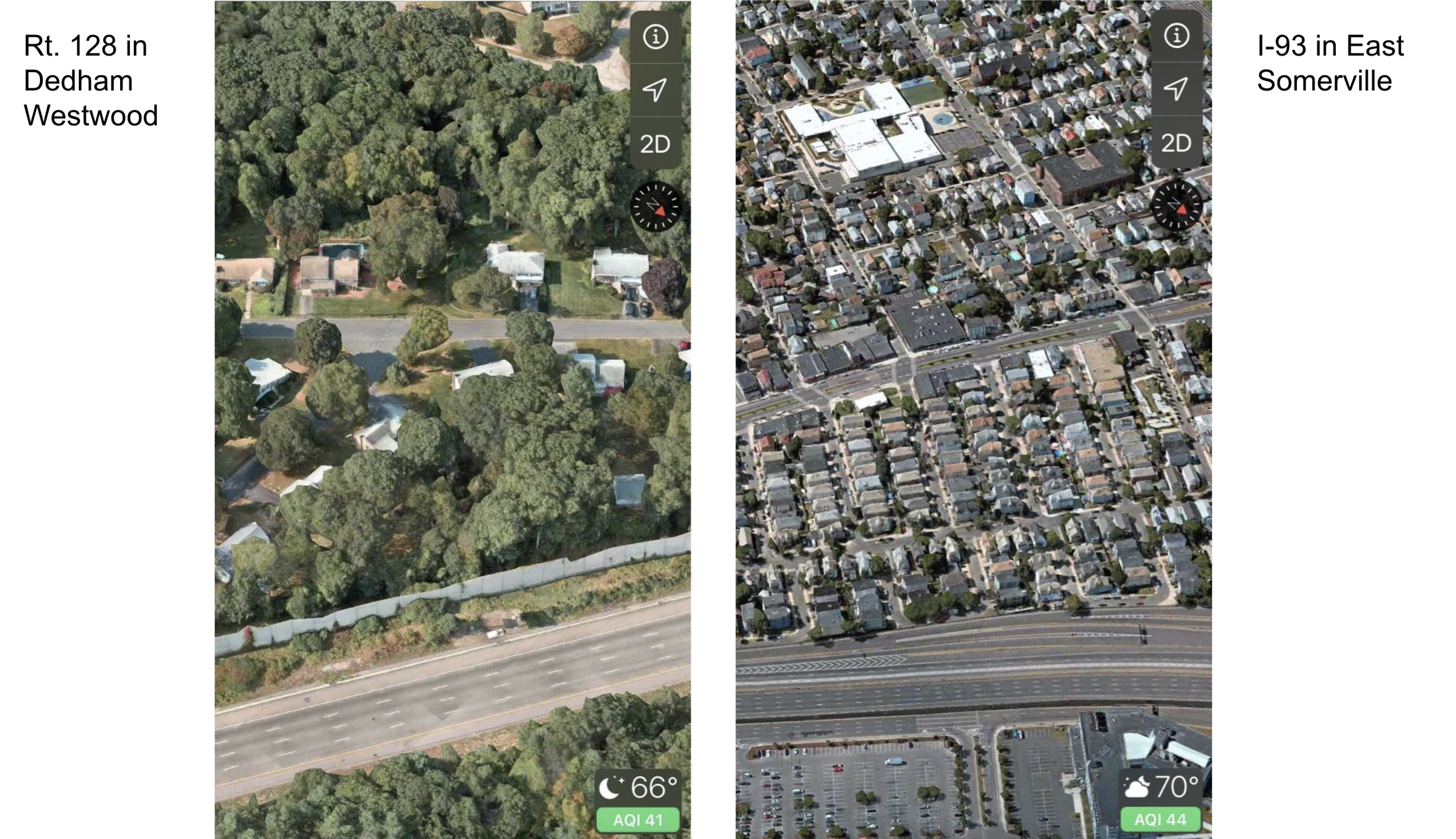
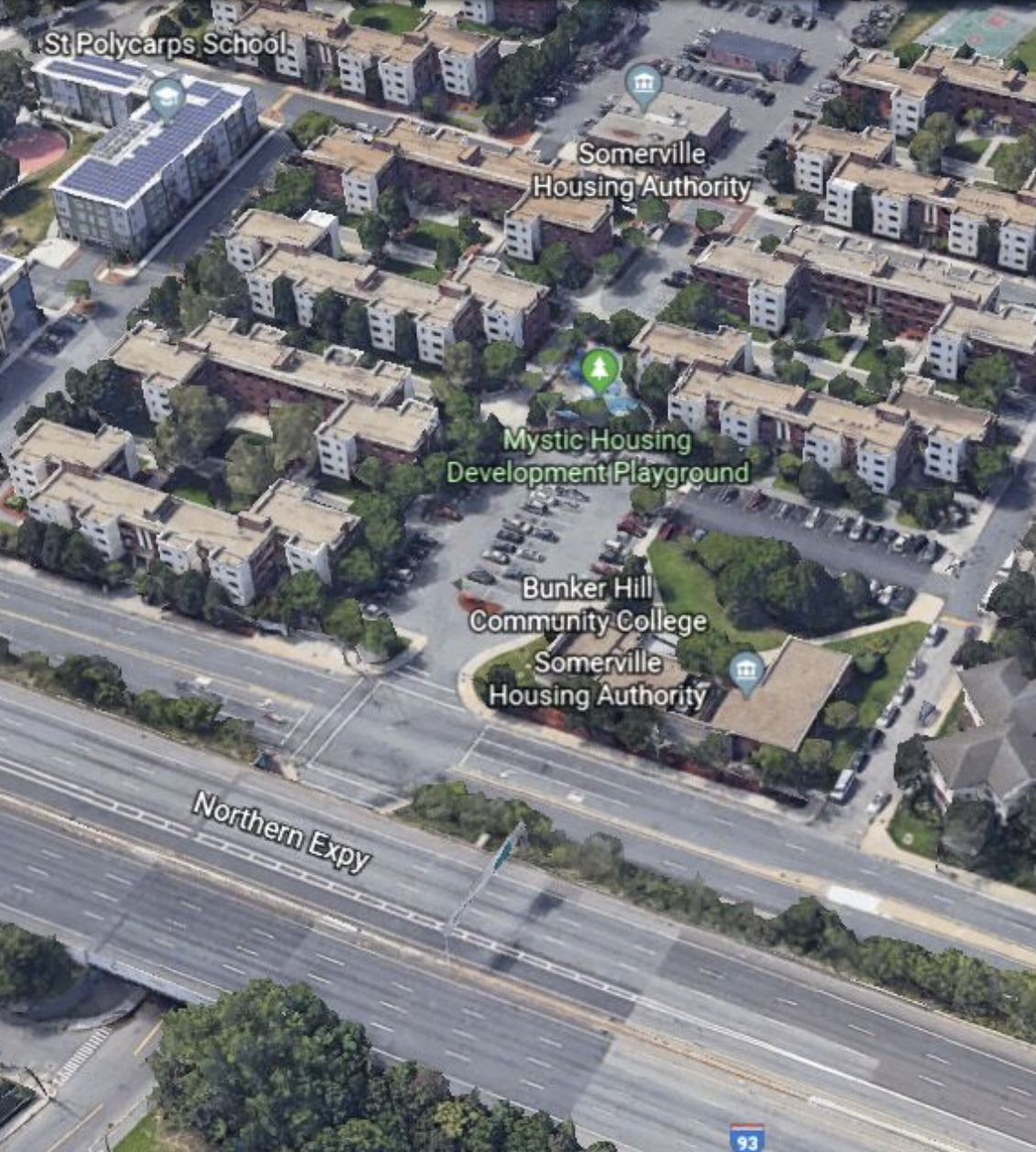 The
Mystic Housing project is within 50-100 m of Rtes 38 and 93. At those
distances they have a 54% higher death rate from heart disease and a 60%
higher rate of lung cancer. By definition, the people who live there
are low-income (with less than 80% of the area’s median household
income) and the proportion of Black and Latino people is twice as high
as in the rest of Somerville and 3 times as high as in Massachusetts. (This CAFEH report image shows how close the buildings are to Route 38 and I-93.) The
Mystic Housing project is within 50-100 m of Rtes 38 and 93. At those
distances they have a 54% higher death rate from heart disease and a 60%
higher rate of lung cancer. By definition, the people who live there
are low-income (with less than 80% of the area’s median household
income) and the proportion of Black and Latino people is twice as high
as in the rest of Somerville and 3 times as high as in Massachusetts. (This CAFEH report image shows how close the buildings are to Route 38 and I-93.)
 The
States Avenues section of East Somerville, where some houses are within
less than 30 feet of highways with 7 or more lanes of traffic, is also
an environmental justice community. The research helps us
understand why people in that neighborhood have died of lung cancer who
never smoked a cigarette. (Image from CAFEH report) The
States Avenues section of East Somerville, where some houses are within
less than 30 feet of highways with 7 or more lanes of traffic, is also
an environmental justice community. The research helps us
understand why people in that neighborhood have died of lung cancer who
never smoked a cigarette. (Image from CAFEH report)
In 2020, Rep. Connolly and I secured $2
million in a bond bill for East Somerville noise barriers, but that
money still has to be released. We also added $30,000 to the FY 2022
budget (which isn't finally adopted yet) for a design study for sound
walls in that area. The Senate version includes examining the
possibility of reducing lanes in that section of Mystic Avenue, which
would allow for more potential solutions.
In 2020, Rep. Barber and I secured $2 million in a different bond bill
for triple glazed windows in the Mystic Housing buildings to mitigate
noise and air pollution, since sound walls may not be possible in that
area. We are working with the Housing Authority, the city, and DHCD to
release and spend those funds.
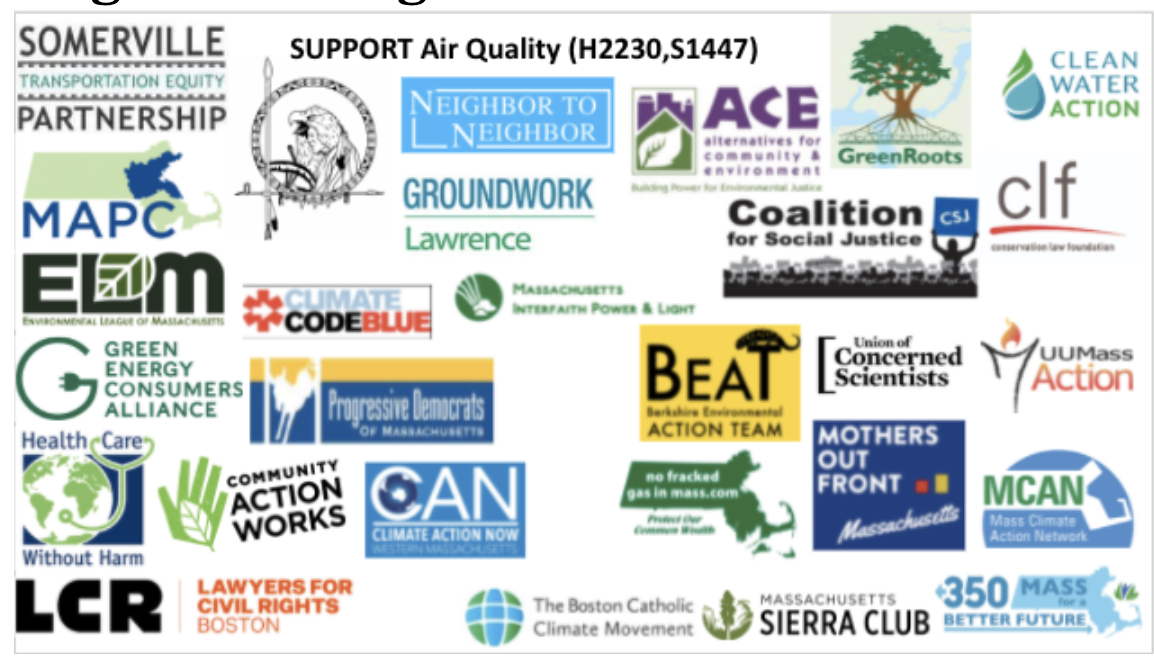 Working
with Ellin Reisner and Wig Zamore of the Somerville Transportation
Equity Partnership as well as many others, Representatives Barber and
Connolly and I filed legislation (H2230 and S1447, An Act to Improve
Outdoor and Indoor Air Quality for Communities Burdened by
Transportation Pollution) which had a well-attended hearing last week.
It's endorsed by the EJ Table and many other groups, shown in the
graphic. You can watch the hearing here. (Our delegation speaks at about 7:00 minutes in; other testimony, including Ellin and Wig, starts at about 2:50:00.) Working
with Ellin Reisner and Wig Zamore of the Somerville Transportation
Equity Partnership as well as many others, Representatives Barber and
Connolly and I filed legislation (H2230 and S1447, An Act to Improve
Outdoor and Indoor Air Quality for Communities Burdened by
Transportation Pollution) which had a well-attended hearing last week.
It's endorsed by the EJ Table and many other groups, shown in the
graphic. You can watch the hearing here. (Our delegation speaks at about 7:00 minutes in; other testimony, including Ellin and Wig, starts at about 2:50:00.)
GREEN LINE EXTENSION NEWS
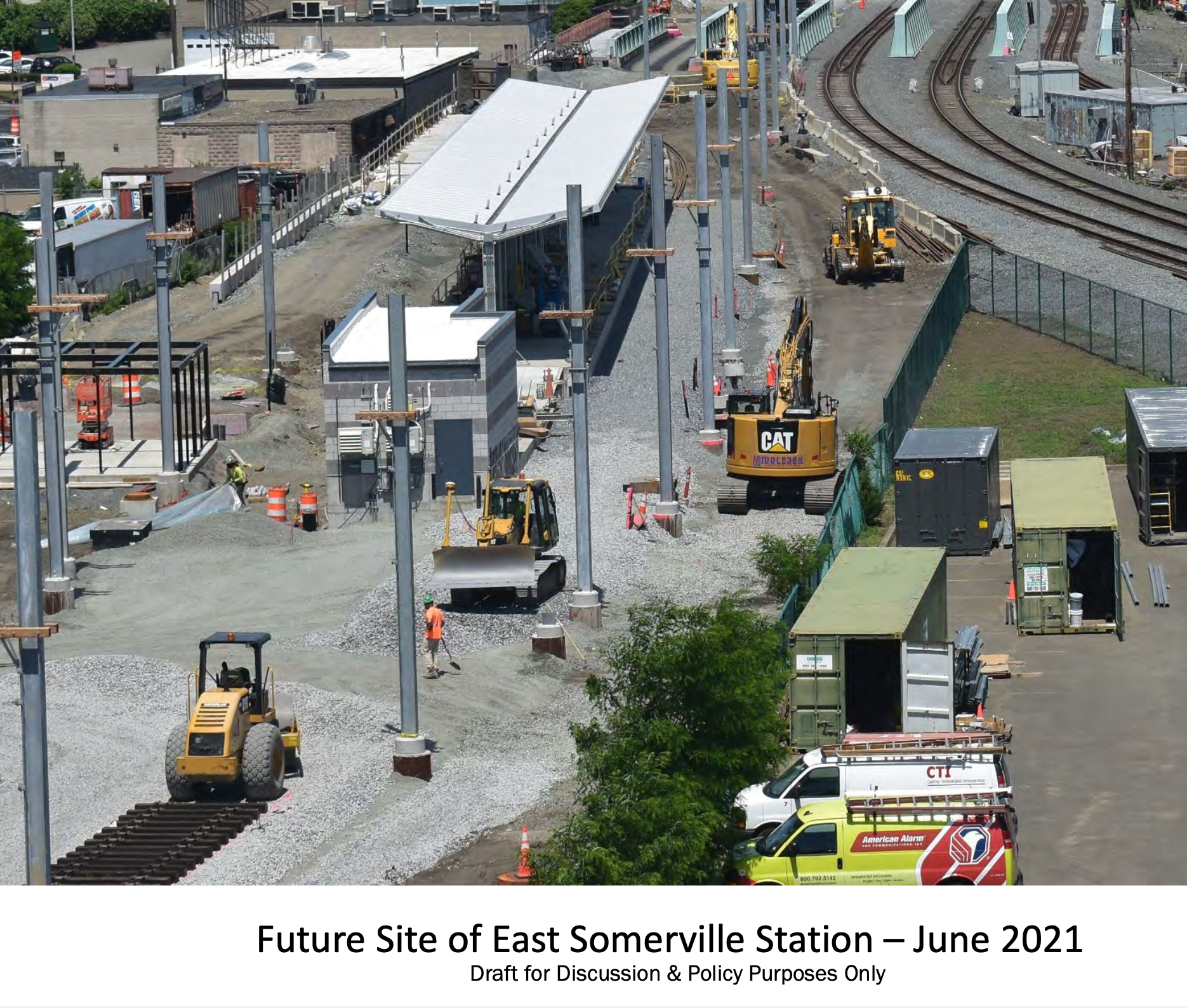 The
Somerville delegation met last week with John Dalton, Program Manager
for the Green Line Extension (GLX), who told us that construction is 80%
complete, with 65% of the track laid. The
Somerville delegation met last week with John Dalton, Program Manager
for the Green Line Extension (GLX), who told us that construction is 80%
complete, with 65% of the track laid.
However, COVID-related and other delays have led to later opening of GLX
service. The Union Square branch is now expected to open this
December, and the full line to Medford/Tufts will open in May 2022.
In 2016, Gov. Baker required Cambridge and Somerville to contribute $25
million and $50 million respectively to keep the GLX alive. Manager
Dalton told us good news: costs have been contained and most if not all
those contributions will no longer be required.
As always, stay in touch on these and other issues,

|
 We hope to hear an update this evening (Wednesday, June 30, 6 pm) on these issues, at an update on the project to preserve the viaduct, the raised portion of I-93. You can register here.
We hope to hear an update this evening (Wednesday, June 30, 6 pm) on these issues, at an update on the project to preserve the viaduct, the raised portion of I-93. You can register here.  In the past two years, three pedestrians - Cheryl Richards, Kevin Dumont, and Marshall Mac
- have been killed in the area where Mystic Avenue, McGrath Highway,
and I-93 come together. For a comprehensive history of problems and
activism in this area, see this post by Rep. Mike Connolly.
In the past two years, three pedestrians - Cheryl Richards, Kevin Dumont, and Marshall Mac
- have been killed in the area where Mystic Avenue, McGrath Highway,
and I-93 come together. For a comprehensive history of problems and
activism in this area, see this post by Rep. Mike Connolly.



 For
60 years, traffic on I-93 has poured air pollution and noise onto
residents along its path in the lowest income part of Somerville. For
decades, activists have pushed for sound barriers along the highway to
protect those residents. Researchers have documented the devastating
damage and continuing danger to people who live along I-93 that runs
through the part of Somerville with the lowest income, and the most
Black and Latino people. They have also documented that that area has
been most affected by COVID-19, for many reasons including lung damage
from long-term exposure to pollution.
For
60 years, traffic on I-93 has poured air pollution and noise onto
residents along its path in the lowest income part of Somerville. For
decades, activists have pushed for sound barriers along the highway to
protect those residents. Researchers have documented the devastating
damage and continuing danger to people who live along I-93 that runs
through the part of Somerville with the lowest income, and the most
Black and Latino people. They have also documented that that area has
been most affected by COVID-19, for many reasons including lung damage
from long-term exposure to pollution. 
 The
Mystic Housing project is within 50-100 m of Rtes 38 and 93. At those
distances they have a 54% higher death rate from heart disease and a 60%
higher rate of lung cancer. By definition, the people who live there
are low-income (with less than 80% of the area’s median household
income) and the proportion of Black and Latino people is twice as high
as in the rest of Somerville and 3 times as high as in Massachusetts.
The
Mystic Housing project is within 50-100 m of Rtes 38 and 93. At those
distances they have a 54% higher death rate from heart disease and a 60%
higher rate of lung cancer. By definition, the people who live there
are low-income (with less than 80% of the area’s median household
income) and the proportion of Black and Latino people is twice as high
as in the rest of Somerville and 3 times as high as in Massachusetts.  The
States Avenues section of East Somerville, where some houses are within
less than 30 feet of highways with 7 or more lanes of traffic, is also
an environmental justice community. The research helps us
understand why people in that neighborhood have died of lung cancer who
never smoked a cigarette.
The
States Avenues section of East Somerville, where some houses are within
less than 30 feet of highways with 7 or more lanes of traffic, is also
an environmental justice community. The research helps us
understand why people in that neighborhood have died of lung cancer who
never smoked a cigarette.  Working
with Ellin Reisner and Wig Zamore of the Somerville Transportation
Equity Partnership as well as many others, Representatives Barber and
Connolly and I filed legislation (H2230 and S1447, An Act to Improve
Outdoor and Indoor Air Quality for Communities Burdened by
Transportation Pollution) which had a well-attended hearing last week.
It's endorsed by the EJ Table and many other groups, shown in the
graphic. You can watch the hearing
Working
with Ellin Reisner and Wig Zamore of the Somerville Transportation
Equity Partnership as well as many others, Representatives Barber and
Connolly and I filed legislation (H2230 and S1447, An Act to Improve
Outdoor and Indoor Air Quality for Communities Burdened by
Transportation Pollution) which had a well-attended hearing last week.
It's endorsed by the EJ Table and many other groups, shown in the
graphic. You can watch the hearing  The
Somerville delegation met last week with John Dalton, Program Manager
for the Green Line Extension (GLX), who told us that construction is 80%
complete, with 65% of the track laid.
The
Somerville delegation met last week with John Dalton, Program Manager
for the Green Line Extension (GLX), who told us that construction is 80%
complete, with 65% of the track laid.


0 comments:
Post a Comment